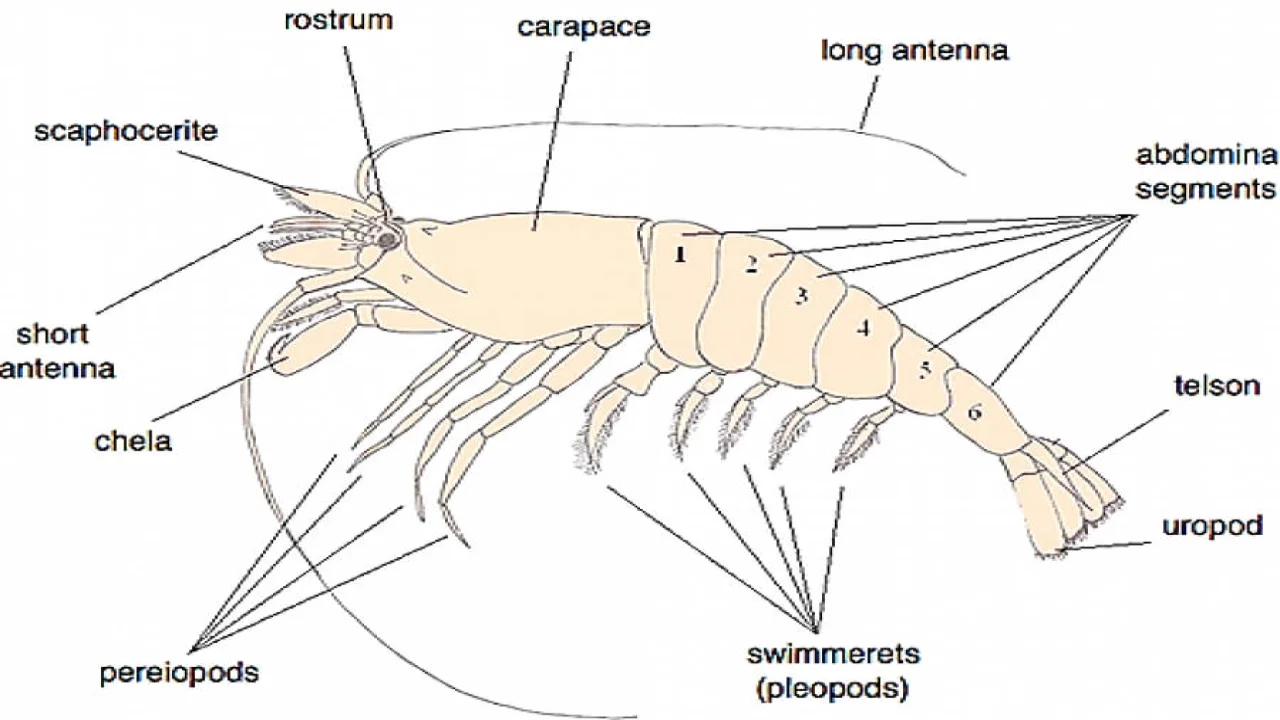Structure of Palaemon (Freshwater Prawn)
Palaemon, the freshwater prawn, has a robust exoskeleton, segmented body, long antennae, and specialized pincers, adapted for its aquatic habitat and scavenging lifestyle.

Palaemon belongs to phylum Arthropoda, sub-phylum Mandibulata, clas Crustacea, sub-class Malacostraca, and order Decepoda.
Introduction
Palaemon is a freshwater prawn. Palaemon inhabits freshwater streams, rivers, lakes, and ponds in India. Dry prawns and fresh prawns are used in various recipes. It prefers clean fresh waters which move, slowly. It remains at the bottom by day and comes to the surface at night and feeds on algae, moss, small insects, and debris. It respires by gills.
External Characters
Palaemon shows an elongated body that is spindle-like and shows bilateral symmetry. It is 25 to 35 cm. long. The entire body is covered by a robust and cuticular exoskeleton. It gives protection against injuries and provides space for muscle attachment. It is formed of sclerites, which are hardened by deposition of calcium salts. They articulate with one another by thin arthrodial membranes.
The body is divided into two parts.
- Cephalothorax, and
- Abdomen.
Cephalothorax
The cephalothorax is large and unsegmented.
- Segments: The cephalothorax shows 13 segments. The first five appendage-bearing segments constitute the head. The remaining eight appendage-bearing segments form the thorax.
- Exoskeleton: The cephalothorax is covered by the dorsal shield and the sternal plates. The dorsal shield consists of the anterior dorsal plate and the posterior carapace. The dorsal plate is triangular. It represents the fused terga of the cephalic segments. It extends forward as a rostrum. Below the base of the rostrum, the dorsal plate has on each side a notch (Orbital notch) in which the short stout eye-stalk is present. The eye-stalks carry eyes. The carapace covers the thorax dorsally and laterally. The carapace hangs freely on either side of the body as a convex gill cover. The space between the thorax and the gill cover is called the chamber. Gills are present in the gill chamber.
- The sternal plates form the floor of the cephalothoracic box.
- Appendages: The cephalothorax bears 13 pairs of appendages. Of these, the anterior 5 pairs belong to the cephalic region and are called the cephalic appendages. The remaining 8 pairs belong to the thorax and are called the thoracic appendages.
Abdomen
The abdomen is six-segmented. It is almost circular in cross-section.
- Segments: The abdomen consists of six segments and a flat conical telson.
- Exoskeleton: Each abdominal segment is covered dorsally by a convex sclerite, the tergum, and ventrally by a flat sclerite, the sternum. The tergum extends downwards on either side as a pleuron. The pleura of 2nd segment are large and cover the pleura of the preceding segment. The pleura of the 6th segment is very small. The adjacent terga and stema are connected by an arthrodial membrane called the intertergal and intersternal membranes respectively. The adjacent terga articulate by a hinge joint on either side.
- Appendages: The abdomen bears six pairs of appendages. These are known as pleopods.
- The slit-like mouth opens midventral at the anterior end of the cephalothorax.
- The anus is a longitudinal aperture present at the base of the telson, ventrally.
- The paired renal apertures open on the inner surface of the coxa of the antennae.
- The paired female genital apertures open on the inner surface of the coxa of the third pair of walking legs in the female.
- The paired male genital apertures are present on the inner surface of the coxa of the fifth pair of walking legs in the male.
- The openings of the statocysts are on the basal segment of each antennule.
The information on this page is peer reviewed by a qualified editorial review board member. Learn more about us and our editorial process.
Last reviewed on .
Article history
- Latest version
Cite this page:
- Comment
- Posted by Dayyal Dungrela